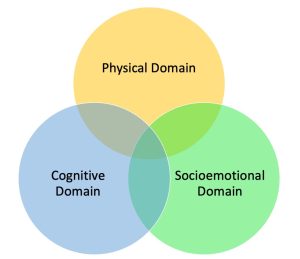Principles of Development
There are several underlying principles of development to keep in mind:
- Development is lifelong and change is apparent across the lifespan (although our course ends with late childhood). And early experiences affect later development.
- Development is multidirectional. We show gains in some areas of development, while showing loss in other areas.
- Development is multidimensional. We change across three general domains/dimensions: physical, cognitive, and socioemotional.
- The physical domain includes changes to our bodies including changes in height and weight, gross and fine motor skills, sensory capabilities, the nervous system, as well as the propensity for disease and illness.
- Example: the average 5 year old is taller than the average 2 year old
- The cognitive domain encompasses the changes in thinking, intelligence, wisdom, perception, problem-solving, memory, and language.
- Example: the number of words a child knows increase as they learn language
- The socioemotional domain (also referred to as psychosocial) focuses on changes in emotion, self-perception, personality and interpersonal relationships.
- Example: my relationship with my mother is different now as an adult than it was when I was 6
- The physical domain includes changes to our bodies including changes in height and weight, gross and fine motor skills, sensory capabilities, the nervous system, as well as the propensity for disease and illness.

- Development is characterized by plasticity, which is our ability to change and that many of our characteristics are malleable. Early experiences are important, but children are remarkably resilient (able to overcome adversity).
- Development is multicontextual.2 We are influenced by both nature (genetics) and nurture (the environment) – when and where we live and our actions, beliefs, and values are a response to circumstances surrounding us. The key here is to understand that behaviors, motivations, emotions, and choices are all part of a bigger picture.3
Periods of Development
Think about what periods of development that you think a course on Child Development would address. How many stages are on your list? Developmental psychologists break this part of the life span into stages as follows:
- Prenatal Development (conception through birth)
- Infancy and Toddlerhood (birth through two years)
- Early Childhood (3 to 6 years)
- Middle and Late Childhood (7 to 11 years)
This list reflects unique aspects of the various stages of childhood that will be explored in this book. So while both an 8 month old and an 8 year old are considered children, they have very different motor abilities, social relationships, and cognitive skills. Their nutritional needs are different and their primary psychological concerns are also distinctive.
Prenatal Development
Conception occurs and development begins. All of the major structures of the body are forming and the health of the mother is of primary concern. Understanding nutrition, teratogens (or environmental factors that can lead to birth defects), and labor and delivery are primary concerns.

Infancy and Toddlerhood
The two years of life are ones of dramatic growth and change. A newborn, with a keen sense of hearing but very poor vision is transformed into a walking, talking toddler within a relatively short period of time. Caregivers are also transformed from someone who manages feeding and sleep schedules to a constantly moving guide and safety inspector for a mobile, energetic child.

Early Childhood
Early childhood is also referred to as the preschool years and consists of the years which follow toddlerhood and precede formal schooling. As a three to six-year-old, the child is busy learning language, is gaining a sense of self and greater independence, and is beginning to learn the workings of the physical world. This knowledge does not come quickly, however, and preschoolers may initially have interesting conceptions of size, time, space and distance such as fearing that they may go down the drain if they sit at the front of the bathtub or by demonstrating how long something will take by holding out their two index fingers several inches apart. A toddler’s fierce determination to do something may give way to a four-year-old’s sense of guilt for action that brings the disapproval of others.

Middle and Late Childhood
The ages of seven through eleven comprise middle and late childhood and much of what children experience at this age is connected to their involvement in the early grades of school. Now the world becomes one of learning and testing new academic skills and by assessing one’s abilities and accomplishments by making comparisons between self and others. Schools compare students and make these comparisons public through team sports, test scores, and other forms of recognition. Growth rates slow down and children are able to refine their motor skills at this point in life. And children begin to learn about social relationships beyond the family through interaction with friends and fellow students.

Our semester will be structured based on these periods of development AND the three domains of development discussed above. For each of the periods, starting with infancy, there will be a chapter for each of the domains (for example there will be three chapters on infancy: Physical Development in Infancy, Cognitive Development in Infancy, and Socioemotional Development in Infancy)
